Social Media Behavior and Emotional Evolution during Emergency Events
Abstract
:1. Introduction
2. Related Work
2.1. Mining Sina-Weibo Data
2.2. Use of Social Media during Emergencies and Crises
3. Data and Methods
3.1. Study Case Description
3.2. Data and Pre-Processing
3.2.1. Data
3.2.2. Data Pre-Processing
3.3. Method
3.3.1. Text Analysis
3.3.2. Sentiment Analysis
4. Results and Discussion
4.1. Temporal Variation of Social Media Activities
4.2. Temporal Variations in the Trending Themes
4.3. Temporal Variation of Public Sentiment
4.4. Correlations between Social Media Activities and Public Sentiment
4.5. Discussion
5. Conclusions and Future Research Directions
Author Contributions
Funding
Data Availability Statement
Conflicts of Interest
References
- Fang, J.; Hu, J.; Shi, X.; Zhao, L. Assessing disaster impacts and response using social media data in China: A case study of 2016 Wuhan rainstorm. Int. J. Disaster Risk Reduct. 2018, 34, 275–282. [Google Scholar] [CrossRef]
- Wang, Y.; Wang, T.; Ye, X.; Zhu, J.; Lee, J. Using social media for emergency response and urban sustainability: A case study of the 2012 Beijing rainstorm. Sustainability 2015, 8, 25. [Google Scholar] [CrossRef]
- Diakopoulos, N.; De Choudhury, M.; Naaman, M. Finding and assessing social media information sources in the context of journalism. In Proceedings of the 2012 SIGCHI Conference on Human Factors in Computing Systems, Austin, TX, USA, 5–10 May 2012; pp. 2451–2460. [Google Scholar] [CrossRef] [Green Version]
- Kwak, H.; Lee, C.; Park, H.; Moon, S. What is Twitter, a social network or a news media? In Proceedings of the 19th International Conference on World Wide Web, Raleigh, NC, USA, 26–30 April 2010; pp. 591–600. [Google Scholar] [CrossRef] [Green Version]
- Starbird, K.; Muzny, G.; Palen, L. Learning from the crowd: Collaborative filtering techniques for identifying on-the-ground Twitterers during mass disruptions. In Proceedings of the 9th International Conference on Information Systems for Crisis Response and Management (ISCRAM 2012), Vancouver, BC, Canada, 22–25 April 2012; pp. 1–10. [Google Scholar]
- Zubiaga, A.; Ji, H.; Knight, K. Curating and contextualizing Twitter stories to assist with social newsgathering. In Proceedings of the 2013 International Conference on Intelligent User Interfaces, Santa Monica, CA, USA, 19–22 March 2013; pp. 213–224. [Google Scholar] [CrossRef] [Green Version]
- Gao, Y.; Wang, F.; Luan, H.; Chua, T.-S. Brand data gathering from live social media streams. In Proceedings of the 2014 International Conference on Multimedia Retrieval, Glasgow, UK, 1–4 April 2014; Volume 169. [Google Scholar] [CrossRef]
- Olteanu, A.; Castillo, C.; Diaz, F.; Kıcıman, E. Social data: Biases, methodological pitfalls, and ethical boundaries. Front. Big Data 2019, 2. [Google Scholar] [CrossRef] [Green Version]
- Sung, K.H.; Lee, M.J. Do online comments influence the public’s attitudes toward an organization? Effects of online comments based on individuals’ prior attitudes. J. Psychol. 2014, 149, 325–338. [Google Scholar] [CrossRef]
- Azar, P.D.; Lo, A.W. The wisdom of twitter crowds: Predicting stock market reactions to FOMC meetings via Twitter feeds. J. Portf. Manag. 2016, 42, 123–134. [Google Scholar] [CrossRef] [Green Version]
- Lee, L.F.; Hutton, A.P.; Shu, S. The role of social media in the capital market: Evidence from consumer product recalls. J. Account. Res. 2015, 53, 367–404. [Google Scholar] [CrossRef]
- Rawat, S.; Divekar, R. Developing a social media presence strategy for an e-commerce business. Procedia Econ. Financ. 2014, 11, 626–634. [Google Scholar] [CrossRef] [Green Version]
- Fu, K.-W.; Chau, M. Reality check for the Chinese microblog space: A random sampling approach. PLoS ONE 2013, 8, e58356. [Google Scholar] [CrossRef] [PubMed] [Green Version]
- Kitsak, M.; Gallos, L.; Havlin, S.; Liljeros, F.; Muchnik, L.; Stanley, H.E.; Makse, H.A. Identification of influential spreaders in complex networks. Nat. Phys. 2010, 6, 888–893. [Google Scholar] [CrossRef] [Green Version]
- Pickard, G.; Pan, W.; Rahwan, I.; Cebrian, M.; Crane, R.; Madan, A.; Pentland, A. Time-critical social mobilization. Science 2011, 334, 509–512. [Google Scholar] [CrossRef] [PubMed] [Green Version]
- Zarrinkalam, F.; Kahani, M.; Bagheri, E. Mining user interests overactive topics on social networks. Inf. Process. Manag. 2018, 54, 339–357. [Google Scholar] [CrossRef]
- Bai, H.; Yu, G.A. Weibo-based approach to disaster informatics: Incidents monitor in post-disaster situation via Weibo text negative sentiment analysis. Nat. Hazards 2016, 83, 1177–1196. [Google Scholar] [CrossRef]
- Zheng, X.; Wang, J.; Jie, F.; Li, L. Two Phase Based Spammer Detection in Weibo. In Proceedings of the IEEE International Conference on Data Mining Workshop IEEE, Atlantic City, NJ, USA, 15–17 November 2015. [Google Scholar] [CrossRef]
- Zhao, Y.L. Feature analysis based on Weibo user interest detection algorithm. Telecom Eng. Tech. Stand. 2012, 25, 79–83. [Google Scholar]
- Wu, X.P. Discursive strategies of resistance on Weibo: A case study of the 2015 Tianjin explosions in China. Discourse Context Media 2018, 26, 64–73. [Google Scholar] [CrossRef]
- Emadi, M.; Rahgozar. M. Twitter sentiment analysis using fuzzy integral classifier fusion. J. Inf. Sci. 2020, 46, 226–242. [Google Scholar] [CrossRef]
- Kuncheva, L.I. Combining Pattern Classifiers: Methods and Algorithms; John Wiley and Sons: Hoboken, NJ, USA, 2014. [Google Scholar]
- Wang, H.; Qian, G.; Feng, X.-Q. Predicting consumer sentiments using online sequential extreme learning machine and intuitionistic fuzzy sets. Neural Comput. Appl. 2012, 22, 479–489. [Google Scholar] [CrossRef]
- Goel, S.; Anderson, A.; Hofman, J.; Watts, D.J. The structural virality of online diffusion. Manag. Sci. 2015. [Google Scholar] [CrossRef] [Green Version]
- Khatua, A.; Khatua, A.; Cambria, E. A tale of two epidemics: Contextual Word2Vec for classifying twitter streams during outbreaks. Inf. Process. Manag. 2019, 56, 247–257. [Google Scholar] [CrossRef]
- Hasan, M.; Orgun, M.A.; Schwitter, R. Real-time event detection from the Twitter data stream using the TwitterNews+ Framework. Inf. Process. Manag. 2018, 56, 1146–1165. [Google Scholar] [CrossRef]
- Derczynski, L.; Albert-Lindqvist, T.O.; Bendsen, M.V.; Inie, N.; Pedersen, V.D.; Pedersen, J.E. Misinformation on Twitter during the Danish national election: A case study. In Proceedings of the 2019 Conference for Truth and Trust Online, London, UK, 4–5 October 2019. [Google Scholar] [CrossRef]
- Falavarjani, S.A.M.; Zarrinkalam, F.; Jovanovic, J.; Bagheri, E.; Ghorbani, A.A. The reflection of offline activities on users’ online social behavior: An observational study. Inf. Process. Manag. 2019, 56, 102070. [Google Scholar] [CrossRef]
- Li, Y.; Guo, H.; Zhang, Q.; Gu, M.; Yang, J. Imbalanced text sentiment classification using universal and domain-specific knowledge. Knowl.-Based Syst. 2018, 160, 1–15. [Google Scholar] [CrossRef]
- Liu, B. Sentiment analysis and opinion mining. Synth. Lect. Hum. Lang. Technol. 2012, 5, 1–167. [Google Scholar] [CrossRef] [Green Version]
- Yang, C.; Zhang, H.; Jiang, B.; Li, K. Aspect-based sentiment analysis with alternating coattention networks. Inf. Process. Manag. 2019, 56, 463–478. [Google Scholar] [CrossRef]
- Liu, Q.N.; Niu, K.; He, Z.Q.; He, X. Microblog User Interest Modeling Based on Feature Propagation. In Proceedings of the 2013 6th International Symposium on Computational Intelligence and Design (ISCID), Hangzhou, China, 28–29 October 2013. [Google Scholar] [CrossRef]
- Xu, K.; Zheng, X.S.; Cai, Y.; Min, H.Q.; Gao, Z.; Zhu, B.J.; Xie, X.R.; Wong, T.L. Improving User Recommendation by Extracting Social Topics and Interest Topics of Users in Uni-Directional Social Networks. Knowl.-Based Syst. 2018, 40, 120–133. [Google Scholar] [CrossRef]
- Wang, S.Q.; Li, C.P.; Wang, Z.; Chen, H.; Zheng, K. BPF++: A Unified Factorization model for predicting retweet behaviors. Inf. Sci. 2020, 515, 218–232. [Google Scholar] [CrossRef]
- Procter, R.; Crump, J.; Karstedt, S.; Voss, A.; Cantijoch, M. Reading the riots: What were the police doing on Twitter? Polic. Soc. 2013, 23, 413–436. [Google Scholar] [CrossRef]
- Alexander, D.E. Social Media in Disaster Risk Reduction and Crisis Management. Sci. Eng. Ethics 2014, 20, 717–733. [Google Scholar] [CrossRef]
- Derczynski, L.; Meesters, K.; Bontcheva, K.; Maynard, D. Helping crisis responders find the informative needle in the tweet haystack. arXiv 2018, arXiv:1801.09633. [Google Scholar]
- Wang, Z.; Ye, X. Social media analytics for natural disaster management. Int. J. Geogr. Inf. Sci. 2017, 32, 49–72. [Google Scholar] [CrossRef]
- Zhang, R.; Lee, H.; Radev, D. Dependency sensitive convolutional neural networks for modeling sentences and documents. arXiv 2016, arXiv:1611.02361. Available online: http://arxiv.org/abs/1611.02361 (accessed on 8 April 2020).
- Cozza, V.; Messina, A.; Montesi, D.; Arietta, L.; Magnani, M. Spatio-temporal keyword queries in social networks. In Proceedings of the East European Conference on Advances in Databases and Information Systems, Genoa, Italy, 1–4 September 2013; Volume 8133, pp. 70–83. [Google Scholar] [CrossRef]
- Pourebrahim, N.; Sultana, S.; Edwards, J.; Gochanour, A.; Mohanty, S. Understanding communication dynamics on Twitter during natural disasters: A case study of Hurricane Sandy. Int. J. Disaster Risk Sci. 2019, 37. [Google Scholar] [CrossRef]
- Teodorescu, H.L. Using analytics and social media for monitoring and mitigation of social disasters. Procedia Eng. 2015, 107, 325–334. [Google Scholar] [CrossRef] [Green Version]
- Middleton, S.E.; Middleton, L.; Modafferi, S. Real-time crisis mapping of natural disasters using social media. IEEE Intell. Syst. 2013, 29, 9–17. [Google Scholar] [CrossRef] [Green Version]
- Chae, J.; Thom, D.; Jang, Y.; Kim, S.; Ertl, T.; Ebert, D. Public behavior response analysis in disaster events utilizing visual analytics of microblog data. Comput. Graph. 2014, 38, 51–60. [Google Scholar] [CrossRef]
- De Albuquerque, J.P.; Herfort, B.; Brenning, A.; Zipf, A. A geographic approach for combining social media and authoritative data towards identifying useful information for disaster management. Int. J. Geogr. Inf. Sci. 2015, 29, 667–689. [Google Scholar] [CrossRef] [Green Version]
- Smith, L.S.; Liang, Q.; James, P.; Lin, W. Assessing the utility of social media as a data source for flood risk management using a real-time modelling framework. J. Flood Risk Manag. 2015, 10, 370–380. [Google Scholar] [CrossRef]
- Alam, F.; Ofli, F.; Imran, M. Descriptive and visual summaries of disaster events using artificial intelligence techniques: Case studies of hurricanes Harvey, Irma, and Maria. Behav. Inf. Technol. 2019, 39, 288–318. [Google Scholar] [CrossRef]
- Dontas, E.; Toufexis, F.; Bardis, N.; Doukas, N. Data acquisition for environmental and humanitarian crisis management. In Green IT Engineering: Components, Networks and Systems Implementation; Springer: Cham, Switzerland, 2017; Volume 105, pp. 87–107. [Google Scholar]
- Dutt, R.; Basu, M.; Ghosh, K.; Ghosh, S. Utilizing microblogs for assisting post-disaster relief operations via matching resource needs and availabilities. Inf. Process. Manag. 2019, 56, 1680–1697. [Google Scholar] [CrossRef]
- Mendoza, M.; Poblete, B.; Castillo, C. Twitter under crisis. In Proceedings of the First Workshop on Social Media Analytics, Washington, DC, USA, 25–28 July 2010; pp. 71–79. [Google Scholar] [CrossRef]
- Mittelstädt, S.; Wang, X.; Eaglin, T.; Thom, D.; Keim, D.; Tolone, W.; Ribarsky, W. An integrated in-situ approach to impacts from natural disasters on critical infrastructures. In Proceedings of the 48th Hawaii International Conference on System Sciences, Kauai, HI, USA, 5–8 January 2015; pp. 1118–1127. [Google Scholar] [CrossRef] [Green Version]
- Ragini, J.R.; Anand, P.R.; Bhaskar, V. Big data analytics for disaster response and recovery through sentiment analysis. Int. J. Inf. Manag. 2018, 42, 13–24. [Google Scholar] [CrossRef]
- Wang, B.; Zhuang, J. Rumor response, debunking response, and decision makings of misinformed Twitter users during disasters. Nat. Hazards 2018, 93, 1145–1162. [Google Scholar] [CrossRef]
- McGregor, S.C. Social media as public opinion: How journalists use social media to represent public opinion. Journalism 2019, 20, 1070–1086. [Google Scholar] [CrossRef]
- Han, X.; Wang, J. Using social media to mine and analyze public sentiment during a disaster: A case study of the 2018 Shouguang City flood in China. ISPRS Int. J. Geo-Inf. 2019, 8, 185. [Google Scholar] [CrossRef] [Green Version]
- Qin, Z.; You, Z.; Jin, H.; Gan, X.; Wang, J. Homophily-driven evolution increases the diffusion accuracy in social networks. IEEE Trans. Netw. Sci. Eng. 2020, 7, 2680–2692. [Google Scholar] [CrossRef]
- Han, K.; He, Y.; Huang, K.; Xiao, X.; Tang, S.; Xu, J.; Huang, L. Best bang for the buck: Cost-effective seed selection for online social networks. IEEE Trans. Knowl. Data Eng. 2019, 32, 2297–2309. [Google Scholar] [CrossRef]
- Gao, J.; Schoenebeck, G.R.; Yu, F. The volatility of weak ties: Co-evolution of selection and influence in social networks. In Proceedings of the 18th International Conference on Autonomous Agents and MultiAgent Systems, Montreal, QC, Canada, 13–17 July 2019. [Google Scholar]
- Chatfield, A.T.; Brajawidagda, U. Twitter tsunami early warning network: A social network analysis of Twitter information flows. In Proceedings of the 23rd Australasian Conference on Information Systems, Geelong, Australia, 3–5 December 2012. [Google Scholar]
- Cheong, F.; Cheong, C. Social media data mining: A social network analysis of tweets during the 2010–2011. Aust. Floods PACIS 2011, 11, 46. [Google Scholar]
- Lu, X.; Brelsford, C. Network structure and community evolution on Twitter: Human behavior change in response to the 2011 Japanese earthquake and tsunami. Sci. Rep. 2014, 4, 6773. [Google Scholar] [CrossRef]
- Chatfield, A.; Scholl, H.J.; Brajawidagda, U. Tsunami early warnings via Twitter in government: Net-savvy citizens’ co-production of time-critical public information services. Gov. Inf. Q. 2013, 30, 377–386. [Google Scholar] [CrossRef]
- Wang, B.; Zhuang, J. Crisis information distribution on Twitter: A content analysis of tweets during Hurricane Sandy. Nat. Hazards 2017, 89, 161–181. [Google Scholar] [CrossRef]
- Li, L.; Zhang, Q.; Tian, J.; Wang, H. Characterizing information propagation patterns in emergencies: A case study with Yiliang earthquake. Int. J. Inf. Manag. 2018, 38, 34–41. [Google Scholar] [CrossRef]
- Caldarelli, G.; De Nicola, R.; Petrocchi, M.; Pratelli, M.; Saracco, F. Flow of online misinformation during the peak of the COVID-19 pandemic in Italy. EPJ Data Sci. 2021, 10, 1–23. [Google Scholar] [CrossRef]
- Blei, D.M.; Ng, A.Y.; Jordan, M.I. Latent Dirichlet allocation. J. Mach. Learn. Res. 2003, 3, 993–1022. [Google Scholar]
- Griffiths, T.L.; Steyvers, M. Finding scientific topics. Proc. Natl. Acad. Sci. USA 2004, 101, 5228–5235. [Google Scholar] [CrossRef] [PubMed] [Green Version]
- Lample, G.; Ballesteros, M.; Subramanian, S.; Kawakami, K.; Dyer, C. Neural architectures for named entity recognition. arXiv 2016, arXiv:1603.01360. [Google Scholar] [CrossRef]
- Elman, J. Finding structure in time. Cogn. Sci. 1990, 14, 179–211. [Google Scholar] [CrossRef]
- Hochreiter, S.; Schmidhuber, J. Long short-term memory. Neural Comput. 1997, 9, 1735–1780. [Google Scholar] [CrossRef]

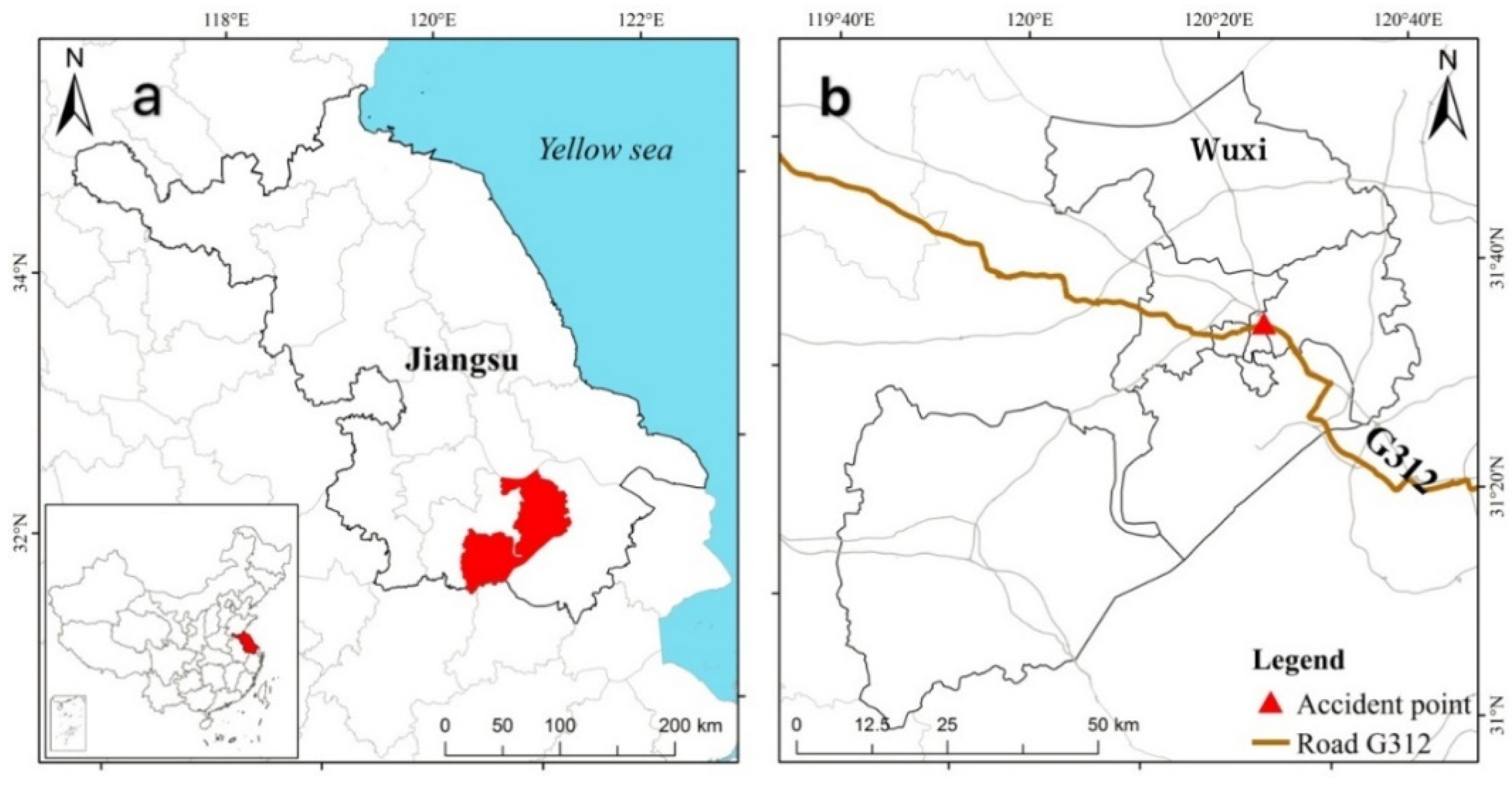
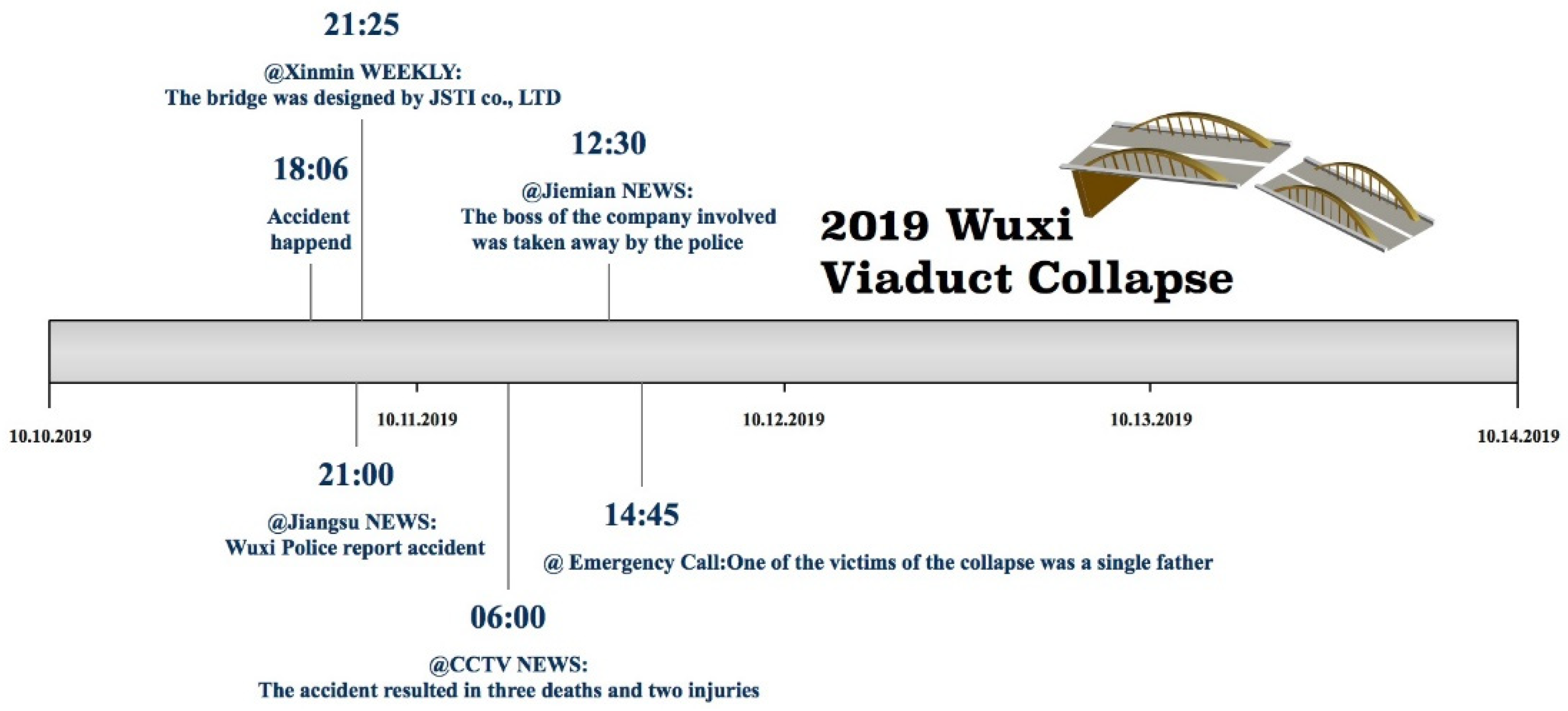

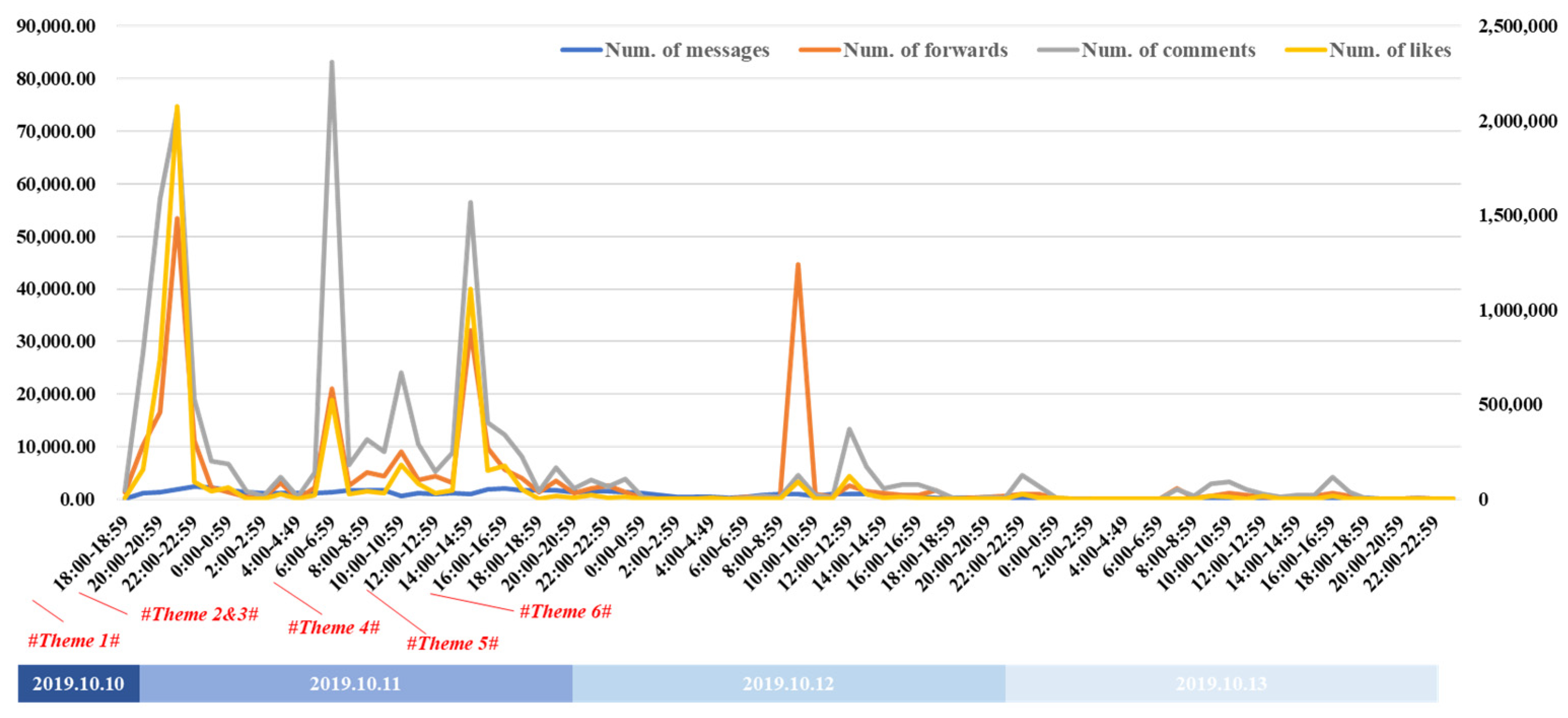

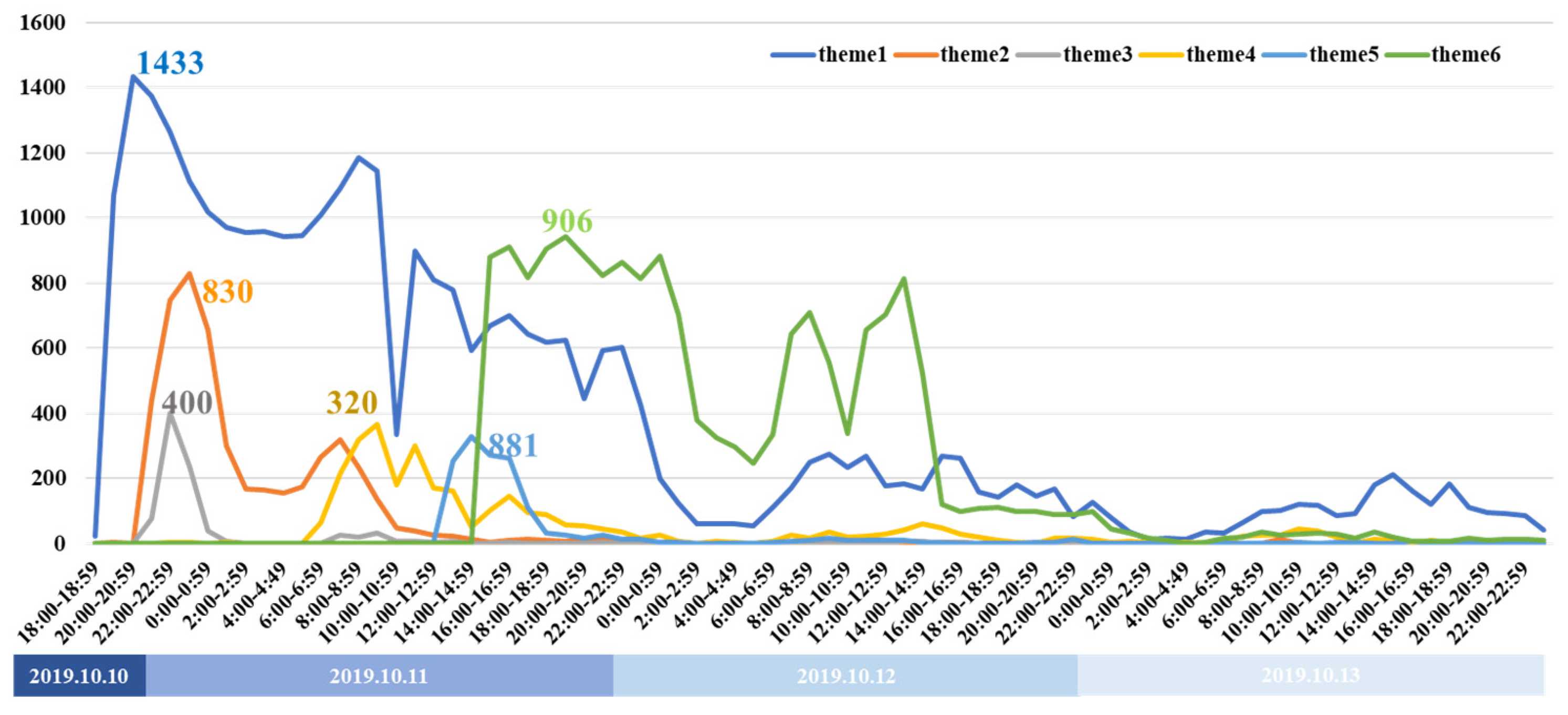
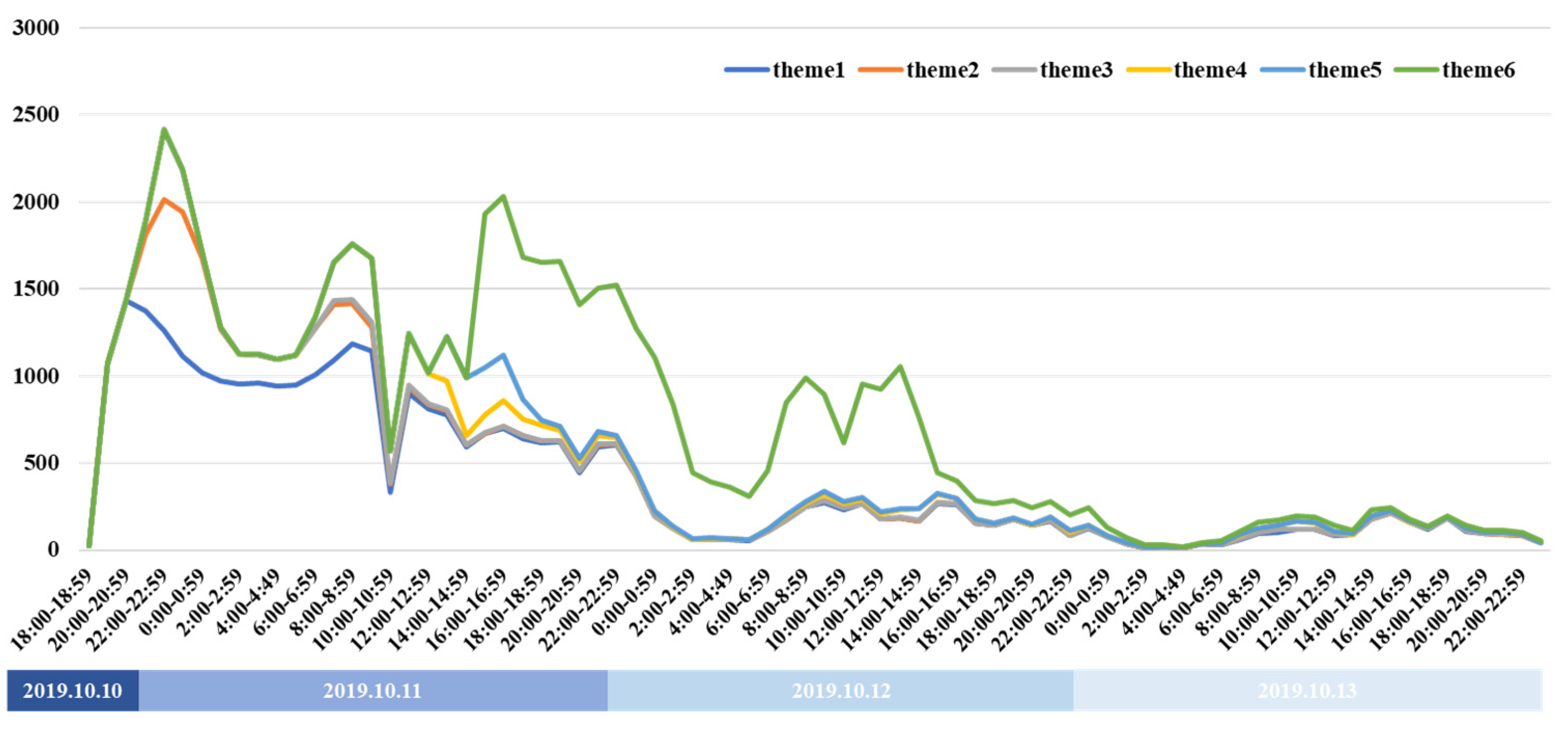
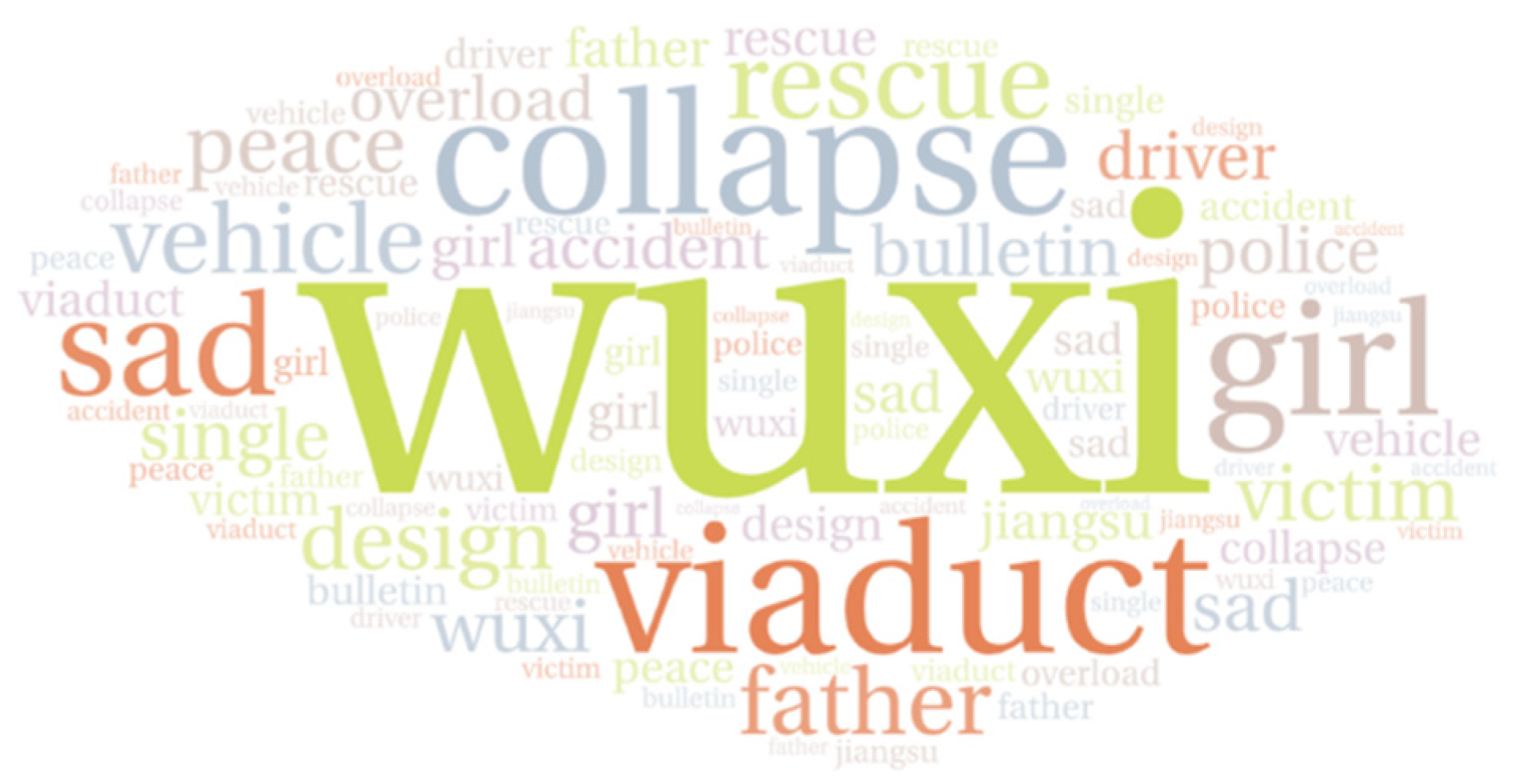


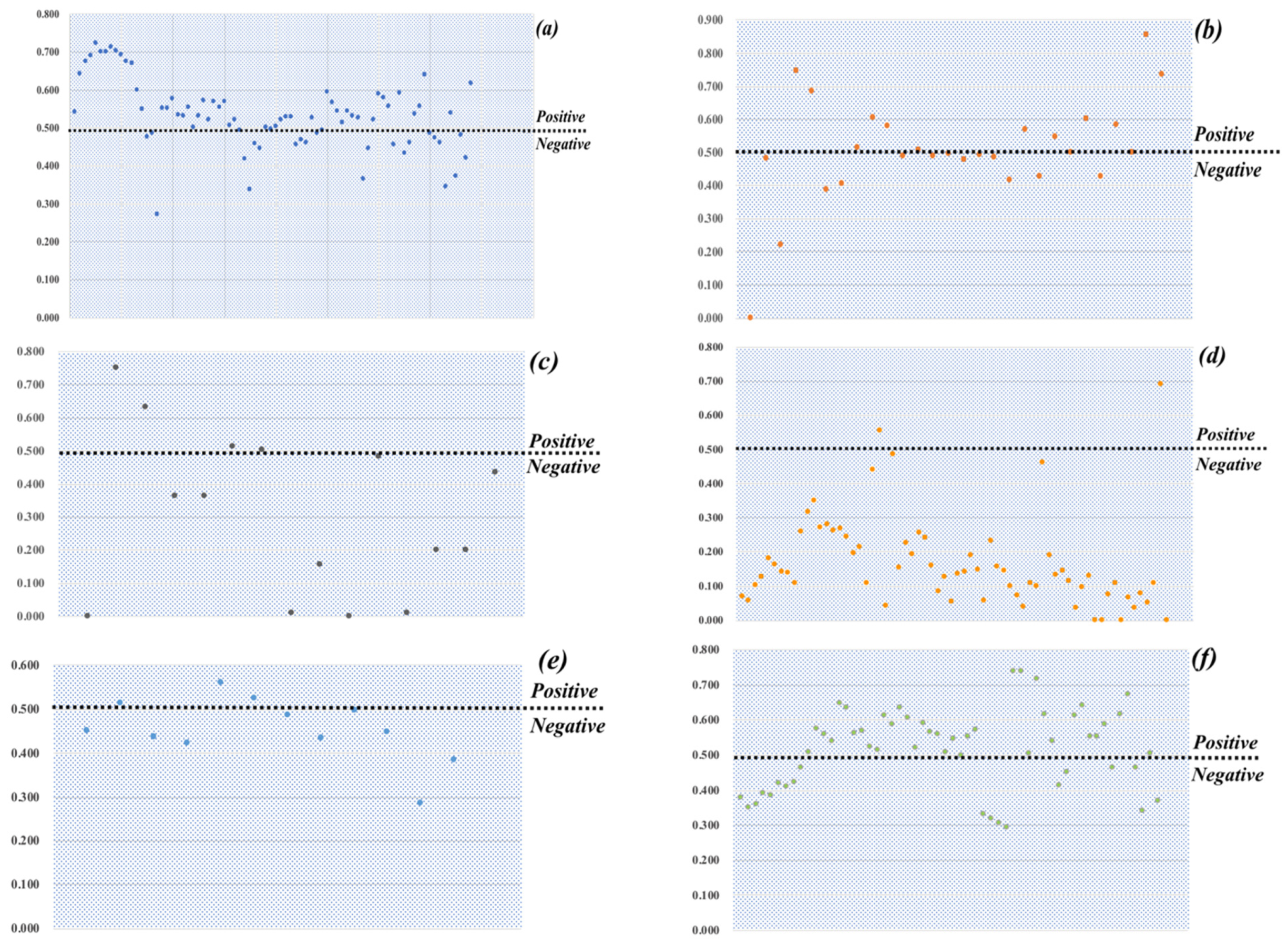
| Theme | Time (2019) | No. of Messages | No. of Comments | No. of Forwards | No. of Likes |
|---|---|---|---|---|---|
| Theme 1 | 18:00 10 October–24:00 13 October | 31,383 | 196,595 | 328,114 | 4,115,813 |
| Theme 2 | 21:00 10 October–24:00 13 October | 4901 | 33,638 | 54,739 | 940,131 |
| Theme 3 | 21:00 10 October–24:00 13 October | 909 | 1643 | 6693 | 31,428 |
| Theme 4 | 06:00 10 October–24:00 13 October | 3222 | 48,951 | 142,368 | 1,047,056 |
| Theme 5 | 12:00 10 October–24:00 13 October | 1518 | 1099 | 4306 | 33,865 |
| Theme 6 | 16:00 10 October–24:00 13 October | 17,330 | 6734 | 4603 | 23,559 |
| Total | 18:00 10 October–24:00 13 October | 59,263 | 288,660 | 540,823 | 6,191,852 |
| Accident Information | Loss and Damages | Questioning of Liability | Emotions | |
|---|---|---|---|---|
| Dataset 1 | 2 | 0 | 3 | 4 |
| Dataset 2 | 1 | 1 | 2 | 3 |
| Dataset 3 | 3 | 0 | 3 | 4 |
| Dataset 4 | 3 | 2 | 1 | 3 |
| Dataset 5 | 3 | 0 | 3 | 0 |
| Dataset 6 | 3 | 0 | 1 | 2 |
| Dataset 7 | 0 | 0 | 9 | 0 |
| Dataset 8 | 1 | 0 | 3 | 2 |
| Dataset 9 | 0 | 2 | 0 | 5 |
| Dataset 10 | 0 | 3 | 0 | 4 |
| Dataset 11 | 0 | 2 | 0 | 6 |
| Total (percentage) | 16(19%) | 10(12%) | 25(30%) | 33(39%) |
| Number of Messages | Personal-Authenticated Accounts | Personal Accounts | Maximum Number of Messages per Minute | ||
|---|---|---|---|---|---|
| Sentiment | P | 0.258 | 0.433 | 0.277 | 0.398 |
| Sig. | 0.023 | 0.000 | 0.014 | 0.000 |
Publisher’s Note: MDPI stays neutral with regard to jurisdictional claims in published maps and institutional affiliations. |
© 2021 by the authors. Licensee MDPI, Basel, Switzerland. This article is an open access article distributed under the terms and conditions of the Creative Commons Attribution (CC BY) license (https://creativecommons.org/licenses/by/4.0/).
Share and Cite
Gu, M.; Guo, H.; Zhuang, J. Social Media Behavior and Emotional Evolution during Emergency Events. Healthcare 2021, 9, 1109. https://doi.org/10.3390/healthcare9091109
Gu M, Guo H, Zhuang J. Social Media Behavior and Emotional Evolution during Emergency Events. Healthcare. 2021; 9(9):1109. https://doi.org/10.3390/healthcare9091109
Chicago/Turabian StyleGu, Mingyun, Haixiang Guo, and Jun Zhuang. 2021. "Social Media Behavior and Emotional Evolution during Emergency Events" Healthcare 9, no. 9: 1109. https://doi.org/10.3390/healthcare9091109
APA StyleGu, M., Guo, H., & Zhuang, J. (2021). Social Media Behavior and Emotional Evolution during Emergency Events. Healthcare, 9(9), 1109. https://doi.org/10.3390/healthcare9091109







